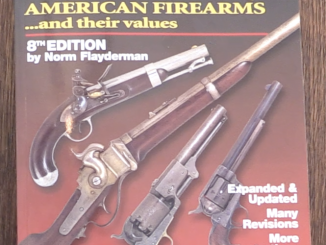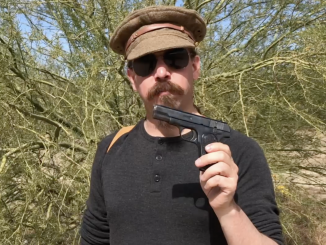Just as World War One broke out in Europe, TC Johnson was working on a new Mauser-based sporting rifle design for the Winchester company. With the war, Johnson added options for military configurations (handguard, bayonet lug, etc) and presented the design (at this point called the Model A) to Winchester management. A few changes were made to simplify production, and the Model B was seen favorably in late 1914. However, at this time Winchester received a contract to produce Pattern 1914 rifles for the British. Johnson was put in charge of overseeing that work, which would take up almost a year of his time.
Once the Model 1914 production was smoothly underway, Johnson returned to his new rifle. The rear sight was now moved back to the receiver bridge like the P14 to become the Model C, and an economy model of the same was named the Model D. By this time the date is 1916, and Winchester was trying to market the Model D as a military rifle to a variety of nations. This particular example is chambered in 6.5 Portuguese (6.5×58mm Vergueiro), because of interest from that country. The most potential, however, came from Russia, and in late 1917 Winchester made a sample batch of 500 Model D rifles chambered for the Russian 7.62x54R cartridge. These rifles were ready in October 1917, which was not exactly an idea time to be making business deals with the Czar – and the whole effort fell apart.
After the was, the Model D was followed by the Model E and Model F, which in turn became the Model 51 and Model 54 and ultimately the Model 70, which is still in production today.
Thanks to the Cody Firearms Museum for allowing me access to film this very rare prototype rifle!




Y’know… I’d love to see someone do a full design history on the Winchester Model 70, with an eye to how much they borrowed/stole from Mauser. I think this is the very first time I’ve actually seen anything on the predecessors to the Model 70, showing where it came from. All the little details, like which Mauser features they copied, and what they left out. I’m not a bolt-action expert, by any means, but I’ve listened to some, and the issues about what Winchester left out or didn’t catch on to were fascinating to listen to, the few times I’ve been around actual subject-matter experts. Not to mention, the innovations Winchester came up with, on their own.
There’s a lot of “inside baseball” stuff with these rifles that isn’t well-known by those of us who aren’t bolt-action experts. It’d be nice to see something like the series on the M1911 or the French rifles… (hint, hint…)
Oh, and if Ian ever makes contact with the French collector that has the Mauser Improved M1918 they show here…?
http://forums.nitroexpress.com/showflat.php?Cat=0&Number=149633&page=6&fpart=1&vc=1
That would be fascinating… Also, if anyone ever gets their hands on the fully-shrouded Schlagelmilch prototype I’ve seen pictures of.
I’ve always wondered what a rotary-bolt straight-pull Schlagelmilch design based on that fully-shrouded design would have looked like. The shroud could have served as the cam path for the bolt, and it would have meant a more-or-less fully sealed receiver that was also open enough for anything that got in to be thrown out with equal facility, and a nice, fast action with minimal fuss and bother to cycle. That’s just me, though…
One does wonder what would have come out of the transition period between bolt-action and full semi-automatic systems, had WWI not gotten in the way. I suspect that Mauser and Schlagelmilch might have come up with some stunning “perfections” of their systems, which we’d probably still be using to this day in both precision shooting and sporting roles…
Yeesh… SCHLEGELMILCH…
Hi Kirk
First things first, here’s Fidel Feederle’s patent for the 1918 Mauser.
https://worldwide.espacenet.com/publicationDetails/originalDocument?CC=US&NR=1413109A&KC=A&FT=D&ND=3&date=19220418&DB=EPODOC&locale=en_EP
According to Speed et al, (Oberndorf factory sporters, collectors grade) There was an attempt to produce that shrouded bolt rifle, as a commercial sporter in the 1920s, with beefed up locking lugs on the bolt.
Bearing in mind that ordinary mauser 98 locking lugs are adequate for the .378 and .460 Weatherby, and that the .500 Schüler (the most powerful factory case for a bolt action sporter, before the .460 weatherby was launched) was designed to work in a standard length mauser 98…
Mauser must have had a particularly heavily loaded, large diameter case in mind, possibly the 7mm Hälger, a ridiculously hot loading of the. 280 Ross case.
I don’t know what period that Mauser sporter that Dorleac & Dorleac sold, came from, or whether it had the beefed up locking lugs.
“…Y’know… I’d love to see someone do a full design history…”(C)
I support!
Especially interesting. Which of these changes turned out to be not the best idea.
And which ones were due to the peculiarities of production.
There are many rumors about these rifles, from quite real problems with strikers to something similar to the hysterics around the M16 and M60 in the style of “total failure and nothing works”…
A lot of the hysterics about the Model 70 are related to design changes Winchester implemented circa 1964 to make the rifle easier and less expensive to produce. The pre-1964 Model 70s have a reputation for being very good, the post-1964 Model 70s a reputation for being not so good. I’m just repeating what I’ve heard and read over the last 50 years – I’ve never fired or even handled a Model 70.
This really does sound like a good idea for a full design history series…..
I liked this Forgotten Weapons presentation–a lot. I’m going to have to make the time to travel to the Cody Firearms museum and see at least their general collection.
Even though it’s in basically the middle of nowhere, it’s worth the trip. Combine it with a trip to Little Bighorn, Buffalo WY for Longmire Days, Yellowstone, Devil’s Tower, or just plain rodeo time in Cody or any nearby town, and the entire state is worth a week, easily.
A lot of the potentially interesting stuff on that model D, isn’t visible in the vid.
Visible differences to the commercial Winchester Model 54 sporters include the external bolt stop and the side mounted ejector
The Winchester model 54, used the sear as the bolt stop, and mounted the ejector blade in the floor of the receiver (Like the Carcano, the 1918 Mauser, and the Newton) sporters) allowing the top / left locking lug to be left without a slot.
It’s not clear whether the firing pin is assembled from the rear, like a mauser, or from the front, like the Krag and Jorgensen, Springfield 1903, Winchester mod 54 and mod 70.
Bolt guide ribs and safety lugs are not visible
There does seem to be more gas shrouding on the bolt sleeve than on either the Springfield 1903, or the later Winchester sporters.
The rear tang of the receiver looks a bit more Mauser like than the tang design which the Springfield 1903 and later Winchester sporters copied from the Krag and Jorgensen.
The use of a cross bolt in the stock, suggests that the recoil lug on the underside of the receiver ring, is smaller than the lugs used on the model 54 and model 70, perhaps more mouser like?
I appreciate that they kept it cock-on-close, which is far better for military use than cock-on-open.
The post ’64 model 70, is a very different rifle to the pre ’64, and to the more recently reintroduced “controlled feed” model 70.
The 1964 changes were mostly centered on the bolt, bolt head and breech face
The bolt became a fabrication with braised on bolt head and bolt handle, rather than being machined from a single piece of bar.
The cone breech and external extractor that derived from the 1903 Springfield were changed for a sliding extractor in the face of the right/ bottom locking lug (actually an earlier Mauser design).
A spring powered plunger ejector in the bolt face replaced the ejector blade in the floor of the bolt way.
I can’t whether the magazine feed lips were still machined into the receiver, or simply pressed into a sheet metal magazine box.
Controlled feed and prevention of double feed jams was no more
Winchester’s marketing people and tame gunzine hacks used the usual logical fallacies, such as “more modern” and appeals to Winchester’s history and past performance, to suggest that the changes were improvements
Rather than attempts to cut manufacturing costs and still sell a different rifle at the same price
In 1968, a bolt guide lug was introduced under the right locking lug, to lessen the tendency of the bolt to cramp during cycling, there was also a “featherweight” with cheaper to produce die-cast aluminium trigger guard and magazine floor plate.
Gas handling in the event of a pierced primer or a case head separation, is not particularly good on any of the Winchester Model 70s.
Cone breeches inevitably give greater case head protrusion than most other designs, and require more care to fit properly,
Going to a flat faced breech, got the post 1964 model 70 to where the Mauser 1889 had been 3/4 of a century before
The Winchester models 54 and model 70s, inherited the striker that was assembled from the front, from the Krag and Jorgensen and the Springfield 1903.
Between the wars, John Garand developed a lighter speedboat striker, with collar attached by lugs to the striker, forming the front support for the mainspring.
This is the system that is als used by Brno/CZ in the Fox and later .22 hornet and. 223 rifles. I’m unsure how long it persisted with the Krico rifles.
This design leaves open the possibility of the lug connection failing and the firing pin going forward
And also of the rear of the firing pin getting blown out of the back of the action.
Both the model 54 and earlier model 70s used a screw through the bolt sleeve and a flat on the side of the striker to positively limit rearward travel of a striker. IIRC, that was omitted as a cost cut, before 1964.
There is no attempt at gas flanging on the rear of a Winchester 54 or 70.
It fell to BRNO (Koucky brothers) and Dakota to put Mauser 98 breeching onto their versions of a model 70 inspired sporter
Ironically, the Brno ZKK was a step down from the earlier and beautiful ZG47.
Winchesters don’t handle case head separations well. Unlike large ring mauser 98 actions, which tend to “blow down”, protecting the firer and bystanders
Winchesters tend to blow the top off the receiver ring, and to allow gas to come out the back
Garand Speed lock
Not speedboat
Does the Winchester Model D uses the M1905 or M1917 bayonet?